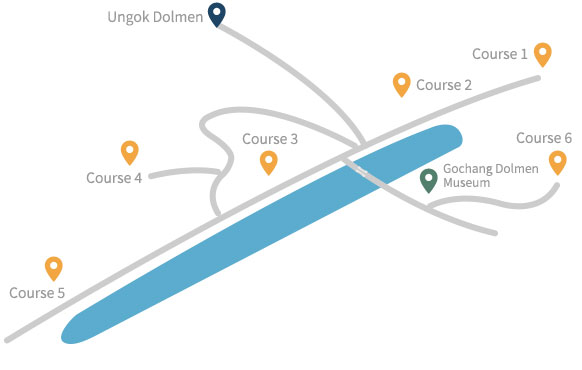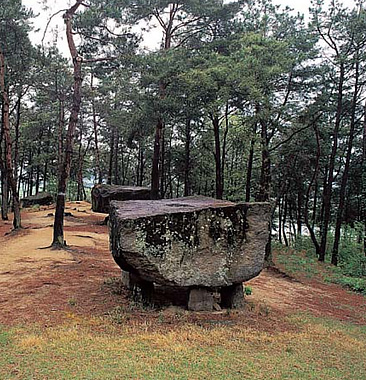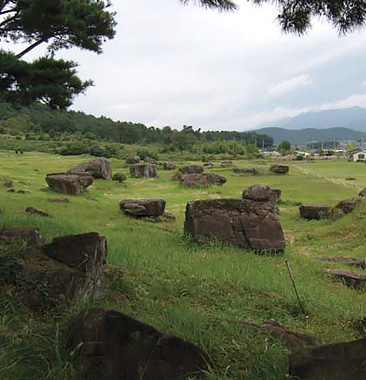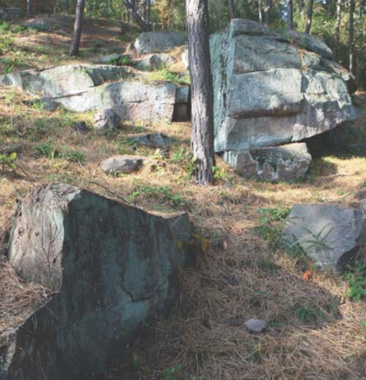Dolmen ruins


Dolmen ruins
Vivid prehistoric remains, Gochang Dolmen course







The Gochang Dolmen Site is an important site for investigating the formation and
development process of Dolmens, as more than hundreds of Dolmens are densely
distributed in one area and various types coexist,
and this is why this has been designated as a World Heritage Site.

- Gochang Dolmen Museum -> Course0.7km
- Gochang Dolmen Museum -> Course 6,1.0km
- Course 1 -> Course 51.8km
- Course 3 -> Ungok Dolmen3.4km
Course 1TOP

Course 1 - Various types such as table type and footing type
53 units including modified table type and typical footing type are distributed
Course 1 Dolmens are located on the southern slope of Mt. Jungbong, and total 53 Dolmens are distributed, including 1 table-type Dolmen, 12 footing-type Dolmens, 28 no-wheel Dolmens, and 12 unknown types. The table-type Dolmen of No. 2509 shows a modified table-type appearance and is stereotyped as its cover stone shows the appearance of 340cm long and 150cm high. However, the lower structure shows a deformed appearance in which two flagstones with 220cm long and 70cm high are placed in parallel with an interval of 80cm. In contrast, Dolmen No. 2513 is a typical footing type Dolmen with 5 wheel stones. The wheel stones that support or pool the cover stone directly support the cover stone and prevent the destruction of the tomb chamber, which is the lower structure, and play a role in making the cover stone look more magnificent. In addition, no-wheel Dolmens, in which a tomb is built underground and a cover stone is placed directly on top of it, are also distributed along with table-type and footing-type Dolmens. As such, Course 1 is a actual education center where you can see various types of Dolmens, such as table type, footing type, and no-wheel Dolmen,s all in one place.
Course 2TOP

Course 2 - A monument to solidify cooperation and unity
Sense of awe at the giant Dolmen weighing 120-150 tons
Currently, 41 Dolmens are distributed along a distance of about 276m from east to west next to Maesan Village, which has been relocated. There are 15 footing-type Dolmens, 11 no-wheel type Dolmens, 1 modified table-type Dolmen, and 14 unknown type Dolmens Dolmens. Among the footing-type Dolmens, the huge Dolmen No. 2406, which weighs 120 to 150 tons, was built as a monument symbolizing an altar or graveyard that exists alone while maintaining a certain distance from the Dolmen graveyard. In a society where Dolmens were built, a symbolic monument was needed to strengthen the cooperation and unity of various groups. These monuments are thought to represent the monuments of the graveyard or to reveal the authority and dignity of the group that constructed the graveyard.
Course 3TOP

Course 3 - The largest concentration area of Dolmens
The original form of the burial site is well preserved having high value
Course 3 Dolmen is located at the center of Gochang Dolmen ruins where the a valley field flowing down from the mountain range between Mt. Seongbong and Mt. Jungbong. There are total 128 Dolmens, including 20 table-type, 17 footing-type, 50 no-wheel-type, and 41 unknown typed Dolmens, but it is thought that more Dolmens existed seeing piles of stones have been formed from destruction of part of cover stones. In 1991, the Mahan Baekje Culture Research Institute of Wonkwang University conducted an excavation and investigation of 16 Dolmens, from Dolmens No. 2318 to No. 2333, which go over to Ungok-ri, for the academic purpose of confirming the process of change in the type of Dolmens. As a result of the investigation, various types of Dolmens were investigated, such as a table type that looks like a table (ground stone tomb), and footing type Dolmen that supports the weight of the cover stone by wheel stones.
Course 4TOP

Course 4 - 23 Dolmen quarries
Ruins where you can see the process of building Dolmens
The quarries where the cover stones of Gochang Dolmens were quarried were found in 23 sites around Mt. Seongteulbong and Mt. Jungbong, which are the back mountains where the Dolmens are located. 15 sites around the top of Mt. Seongteulbong and 8 sites around Mt. Jungbong were investigated, and it was found that Dolmens exist in a wide range, mainly clustering at the 7th and 8th ridges. The main components of the rocks of 447 Dolmens are decite tuff and andesite porphyry, which are the same as those of the quarry. The quarry at point K is located at about 80-85m above sea level if you go north along the signboard that reads 'The way to the Dolmen quarry' at the back of course 3. The original stone is in the size range of 40m × 20m, and there are scattered stones that can be used as cover stones for medium-large Dolmens. The traces of separation from the original stone are mainly visible on the front side. Using the joint surface of the original stone, a V-shaped groove was made long on the joint surface, a wedge was driven in, and then the top was struck to remove it. Traces of wedges driven through holes remain, and rocks that have fallen from the original stone and rolled down remain around it. In this way, it has been confirmed that the quarry of the Gochang Dolmen ruins used the method of driving a wedge through the gap in the joint surface of the original stone to remove it. Various types of Dolmens were investigated, such as a stacking type and a footing type in which the cover stone is piled only with wheel stones.
Course 5TOP

Course 5 - Dolmens distributed in rows
A large number of small Dolmens around 2m are distributed in parallel.
Course 5 Dolmens are distributed in parallel to the flow of Gochang river on the southern slope of Mt. Seongteulbong. Total 220 Dolmens are distributed, including 25 deformed table-type Dolmens, 40 footing-type Dolmens, 130 no-wheel stone type Dolmens, and 25 Dolmens of unknown type. This place, which stretches across Sanggap-ri and Juknim-ri, can be divided into 5 small Dolmen clusters, and you can meet small Dolmens around 2m in size and rows of Dolmens. As the Dolmens are grouped and most of them appear in rows, they are regarded as a common graveyard for a group based on blood ties, or presumed to be a graveyard for a ruling group.
Course 6TOP

Course 6 - A typical table-type Dolmen
Five Dolmens, including table-type Dolmens, located in private houses in the village
Dosan-ri Dolmen is known as a Dolmen located in a private house in Dosan Village, 1.0 km away from the Gochang Dolmen Museum. Total 5 Dolmens, including 1 table-type Dolmen, 2 footing-type Dolmens, and 2 no-wheel stone type Dolmens, are distributed on a hill with an altitude of 43m. A table-type Dolmen is a tomb chamber built with wide flagstones exposed to the ground. It is called a table-type Dolmen because a cover stone is placed on top of the tomb chamber built with 4 or 6 flagstones, making it look like a desk. These typical table-type Dolmens in Dosan-ri are also well known as Jangdokdae Dolmens. A 350 cm long x 310 cm wide x 38 cm thick cover stone and 2 wheel stones were used and their scale was measured to be 314 cm x 164 cm x 30 cm and 307 cm x 168 cm x 26 cm respectively. On the side of the cover stone, there are groove marks for fixing the line when moving, and in-between the wheel stones and the cover stone, a wedge stone with a length of about 20 cm was inserted, and the gap was filled with soil.